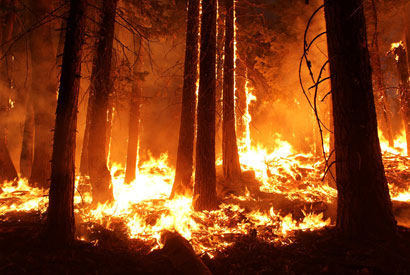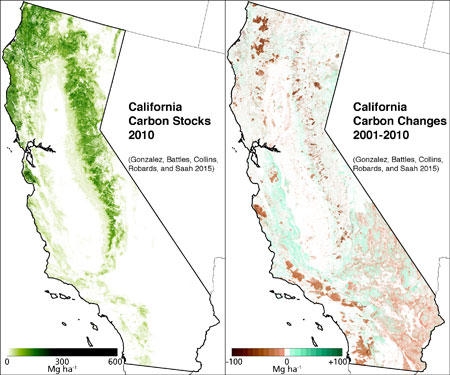Wildfires Emit More Greenhouse Gases Than Assumed in State Climate Targets
A new study quantifying the amount of carbon stored and released through California forests and wildlands finds that wildfires and deforestation are contributing more than expected to the state’s greenhouse gas emissions.

The findings, published online today (Wednesday, April 15), in the journal Forest Ecology and Management, came from a collaborative project led by the National Park Service and UC Berkeley. The results could have implications for California’s efforts to meet goals mandated by the state Global Warming Solutions Act, or AB 32, to reduce greenhouse gas emissions to 1990 levels by the year 2020. The bill, which passed in 2006, assumed no net emissions for wildland ecosystems by 2020.
The researchers noted that the information available at the time the bill was passed may have underestimated the release of carbon through landmass conversions and wildfires, which are projected to increase in intensity in the western United States due to climate change. The authors pointed out that California is one of the few jurisdictions in the world to set mandatory greenhouse gas emissions targets.
“Determining the balance between carbon storage and emissions is essential for tracking the role of ecosystems in climate change. Growing vegetation naturally removes carbon from the atmosphere, reducing the magnitude of climate change,” said study lead author Patrick Gonzalez, the National Park Service climate change scientist. “Conversely, burned or dead vegetation releases carbon into the atmosphere, exacerbating climate change.”
Gonzalez worked with forest ecologist John Battles, a professor in UC Berkeley’s Department of Environmental Science, Policy and Management and the principal investigator on the project to quantify carbon storage and emissions in the state’s wildlands.

The study, funded by the California Air Resources Board, used 2001-2010 data from multiple public sources, including plot-level carbon stocks from the U.S. Department of Agriculture’s Forest Inventory and Assessment Program and U.S. Landfire remote sensing data of vegetation at a 30-meter spatial resolution.
The analysis confirmed that California’s forests are huge carbon reservoirs for the state. Previous research has found that redwood forests near Redwood National Park contain the most carbon per hectare on the ground of any ecosystem in the world. One hectare of redwood forest can store an amount of carbon equivalent to the annual greenhouse gas emissions generated by more than 500 Americans. The giant sequoia forests of Sequoia and Kings Canyon National parks come in second.
Altogether, the forests and vegetation of state wildlands stored an estimated 850 million tons of carbon in 2010. However, those areas also accounted for approximately 69 million tons of carbon emitted between 2001 and 2010. Two-thirds of the carbon loss came from fires that burned just 6 percent of the area of wildlands in nine years. Annual carbon losses from forests and wildlands in California represent as much as 5 to 7 percent of state carbon emissions from all sectors between 2001 and 2010, according to the study.
“National parks and other protected areas clearly provide an important function in removing carbon from the atmosphere and storing it,” said Battles. “But we also know from previous research that a century of fire suppression has contributed to a potentially unsustainable buildup of vegetation. This buildup provides abundant fuel for fires that contribute to carbon emissions. Projections of more wildfires in the West mean that we need to account for this source of carbon emissions. Meeting the state greenhouse gas targets for 2020 might require a reconsideration of wildland management policies.”
This research is among the latest examples of the long, productive partnership between UC Berkeley and the National Park Service, highlighted in the recent “Science for Parks, Parks for Science” summit commemorating the centennial of the National Park Service.
Other co-authors of the study include researchers from the U.S. Forest Service, the Spatial Informatics Group in Pleasanton, California, and the University of San Francisco.
RELATED INFORMATION
- Aboveground live carbon stock changes of California wildland ecosystems, 2001-2010 (Link to study abstract)
- Back to the future: Berkeley and the national parks start a second century of science
- Research profile for John Battles
